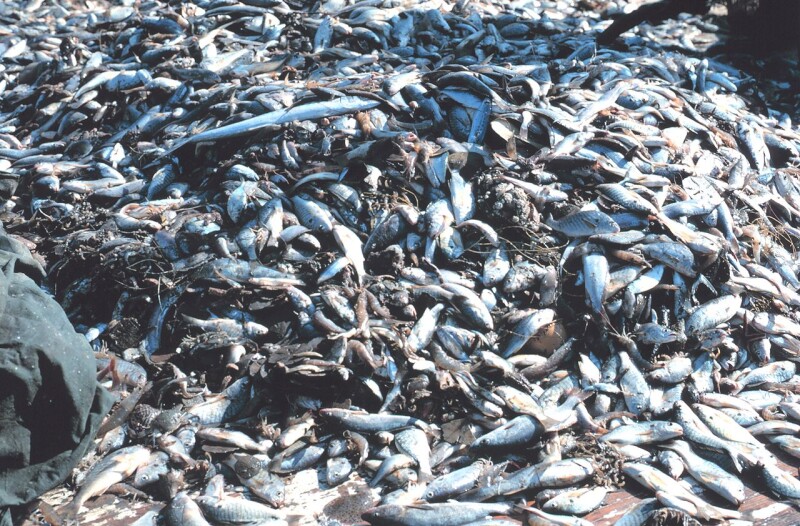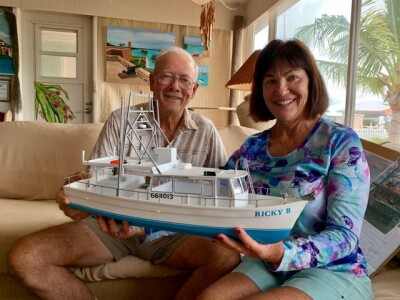The agency that oversees the performances of federal agencies gave a sobering assessment of those tasked with monitoring bycatch in US fisheries.
That oversight falls to the National Marine Fisheries Service (NMFS), also called NOAA Fisheries, which agreed with the troubling performance outlined in a report by the Government Accountability Office (GAO).
In a June report to the U.S. House Natural Resources Committee titled “Efforts to Reduce and Monitor Unintentional Catch and Harm Need Better Tracking,” the GAO addressed four issues: measures used to reduce bycatch, coverage, and funding of fisheries observers, how bycatch estimates are developed and reported and how NMFS tracks its performance towards reducing and monitoring bycatch.
It added: “NMFS’ efforts to track its performance in reducing and monitoring bycatch do not align with key elements of evidence-based policymaking related to performance management.”
The GAO outlined numerous ways in which NMFS has failed to adequately tackle bycatch issues and blamed a lack of observer coverage overall. NMFS replied that it needs more funding to recruit and retain observers, but it hasn’t communicated that need to Congress.
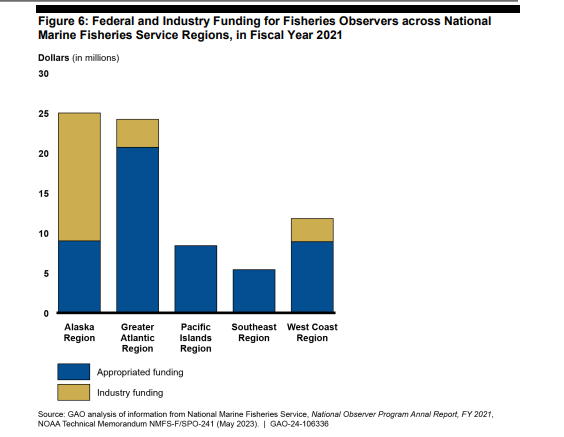
The NMFS issued its National Bycatch Reduction Strategy in 2016 and implemented the plan in 2019.
The GAO report said that in developing the plan, “NMFS did not create measurable performance goals, including goals that have quantitative targets and specific time frames against which performance can be measured. Additionally, NMFS did not develop a process for regularly tracking the actions in the plan.”
The report added that while NMFS has taken steps to compile better bycatch estimates, it does not have any comprehensive plan on how to actually report those estimates.
The GAO and NMFS agreed that fishery observers are key to gathering bycatch data. and that coverage varies widely across fisheries, and retention of observers is an ongoing challenge.
“NMFS officials told us that noncompetitive compensation and difficult working conditions hamper the recruitment and retention of observers,” the GAO report said. It added that in its investigation, it found that “NMFS did not do enough to actually describe why limited observer coverage was such a limiting factor on bycatch estimation, or what additional resources it needs to address the challenges it says it has.”
Five U.S. fisheries assessed in-depth
The GAO report assessed five fisheries to derive its conclusions: Bering Sea pollock trawl, Gulf of Mexico shrimp trawl, Hawaii deep-set tuna longline, New England scallop dredge, and West Coast groundfish fixed gear.
Each includes fishery profiles, bycatch data collection, and estimates and examples of bycatch reduction measures. Here’s a sampler:
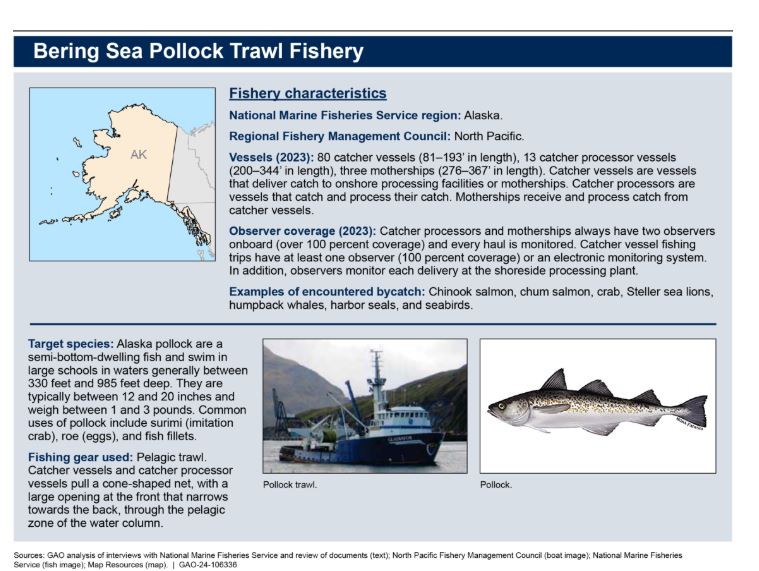
The Bering Sea pollock fishery annually includes 80 catcher vessels, 13 catcher processors and three motherships. The GAO report says, “According to NMFS officials from the Alaska region, the Bering Sea pollock trawl fishery is considered one of the most heavily monitored U.S. commercial fisheries” with at least 100% observer coverage, meaning at least one observer is present on every trip.” Because pollock is such a high-volume fishery, “for most bycatch species, observers collect data by taking samples from each haul and NMFS officials extrapolate bycatch estimates to the total catch.”
In 2023, the Bering Sea trawl fishery caught over 2.7 billion pounds of pollock and estimated fish bycatch was 13.2 million pounds. The trawlers “also caught nearly 12,000 Chinook salmon, among other prohibited species catch.”
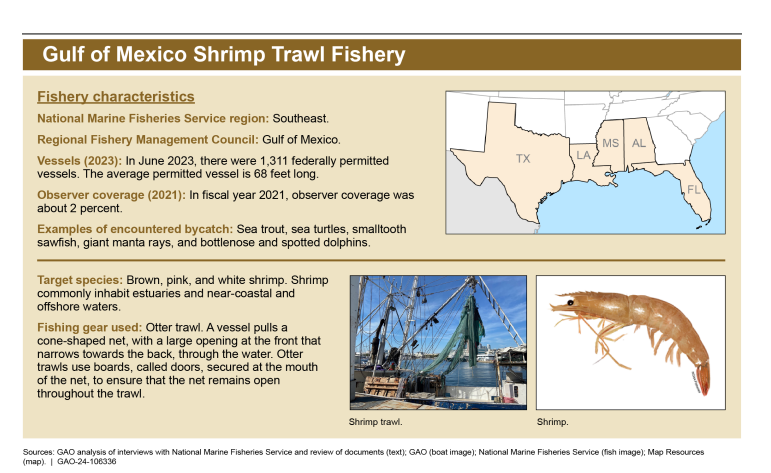
The Gulf of Mexico trawl shrimp fishery includes a fleet of 1,311 boats with an average length of 68 feet. Observer coverage in 2021 was 2%.
The GAO report said: “We asked NMFS to provide us any available information on bycatch estimates for the fishery for the years 2018–2022. NMFS said they did not have bycatch estimates for fish or protected species for that time frame.”
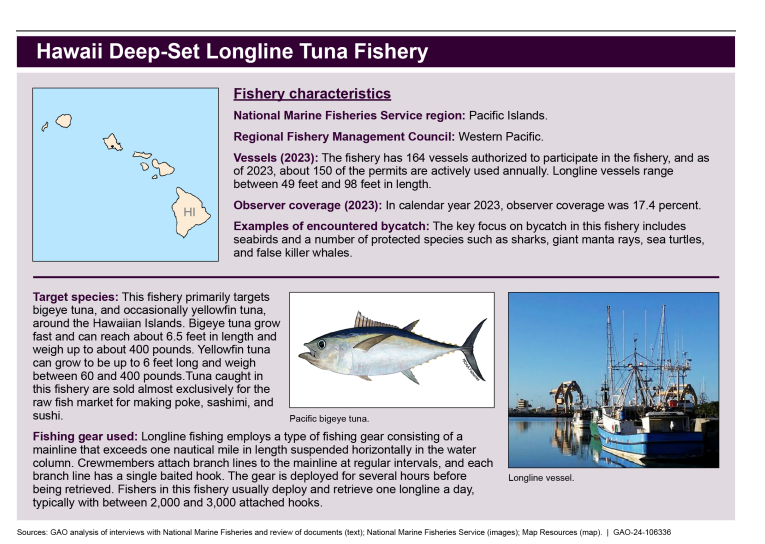
The Hawaii deep set longline tuna fishery comprises 164 permitted vessels ranging in length from 49 to 98 feet. Observer coverage in 2023 was 17.4%.
The GAO report said: “We asked NMFS for any available information on bycatch estimates for the fishery for fiscal years 2018 through 2022. The estimated bycatch, in number of fish for species that comprise over 90% of its total bycatch in 2021 was 521,924 fish. In 2022, the estimated bycatch for oceanic whitetip shark was 3,084, and for giant manta rays was 11.7.”
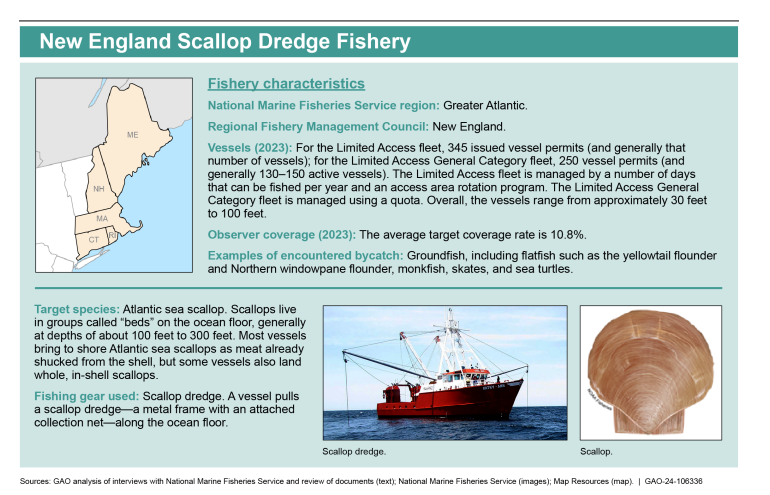
For the New England scallop dredge fishery, bycatch data estimates for 2018-2022 “did not reflect extrapolation in order to generate bycatch estimates for the fishery as a whole.” The average observer coverage rate was 10.8%.
The GAO report said: “The total observations of bycatch for fish in 2021 was 23,790,617 pounds. The total number of incidental takes for other bycatch in 2021 was 11.”
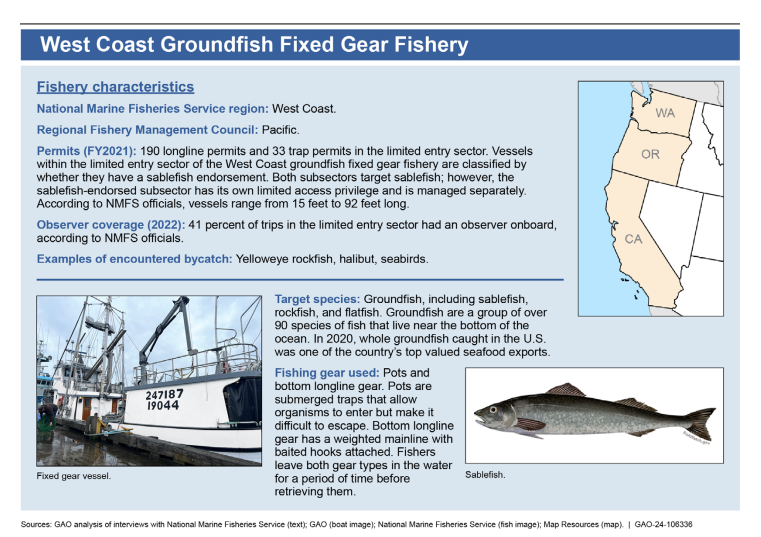
The West Coast groundfish fixed gear fishery includes 190 longline permits with vessels ranging in size from 15 to 92 feet, and 33 pot permits. Both target sablefish. Observer coverage in 2022 was 41%. NMFS officials told the GAO that “the lag between when the data are collected and estimates are published means that the information is not available for the Pacific Council to make management decisions during the fishing season,” and that as of 2023 “no electronic monitoring was used in the fishery.”
In 2022, the fishery landed approximately 716 metric tons of groundfish(1,575,200 pounds) and discarded approximately 425 metric tons of groundfish (935,000 pounds). The discards included 3 metric tons (6,600 pounds) of yelloweye rockfish and 42 metric tons (92,400 pounds)of Pacific halibut, among other species. Other bycatch included seabirds, among them 48 black-footed albatrosses and marine mammals, including 2.7 California sea lions.
GAO recommendations
To better track and reduce bycatch, the General Accounting Office makes four recommendations. NFMS should:
- Gather information from across the regions to identify any additional resources needed to support fisheries observers, and communicate these needs to relevant stakeholders, including Congress.
- Develop an updated National Bycatch Reduction Strategy Implementation Plan with measurable performance goals tied to specific time frames.
- Develop a process for tracking progress toward the performance goals in the updated National Bycatch Reduction Strategy Implementation Plan and use the information to guide agency decision-making.
- Develop a comprehensive written plan for reporting on bycatch estimates from the enhanced Fisheries One Stop Shop database, including how the agency will communicate overtime on bycatch levels, trends, and information gaps.
NFMS said, “it agrees with the GAO’s recommendations to improve bycatch tracking and reporting,” and is in the process of developing a working group to revise the National Bycatch Reduction Strategy Implementation Plan. NMFS plans to report its progress in developing an enhanced Bycatch Report National Database to share bycatch estimates.





